Solar Symphony in Aurora City reading Exercise
Follow the Aurora Energy League as they diagnose a neighborhood’s stressed solar microgrid, collect rooftop data, and design a plan that balances science, engineering, and community needs.
Exercise Guide
How to complete:
Read each passage in sequence—the investigation moves from rooftop surveys to digital simulations and finally a community forum. Annotate important measurements, hypotheses, and decisions. After every passage, answer the questions by pointing to the textual evidence.
Success tips:
These passages highlight the engineering design cycle. Track how the team defines the problem, gathers data, models solutions, and communicates results.
- Underline technical vocabulary—irradiance, albedo, bypass diode, dispatch algorithm.
- Connect each measurement to the decision it influences.
- Compare team roles: engineering, data analysis, drone mapping, community outreach.
- Watch where assumptions are tested, revised, or confirmed.
- Summarize each section to keep the project timeline clear.
Knowledge:
You will encounter concepts such as photovoltaic efficiency, thermal imaging, spectral analysis, digital twins, battery management, and participatory planning. The passages strengthen skills in interpreting procedural texts, analyzing evidence, and understanding STEM collaboration.
Complete the Exercise
Reading Passage 1
The Aurora Energy League rolled a mobile lab into the Midtown Maker Hub as dawn painted copper streaks across the skyline. A late-summer heat wave had exposed weaknesses in the district's solar microgrid: batteries drained before midnight, emergency shelters flickered, and residents restarted diesel generators. Project lead Amara outlined the mission—find why production lagged despite clear forecasts and deliver a community-ready fix within seven days.
Electrical engineer Marco unpacked a solar spectrum analyzer aligned to the module manufacturer's reference curve. Statistician Hana set up irradiance sensors and pyranometers on tripods, while drone pilot Selene checked quadcopters fitted with multispectral cameras. Community liaison Javier distributed surveys to shop owners, noting reflective paint, new HVAC units, and shade pergolas added since the last inspection.
Before the crew split up, Amara posted a color-coded systems map: inverters feeding clinics, cooling centers, and adaptive traffic signals, plus battery cabinets staged near elementary schools. She assigned Marco and Selene to rooftop diagnostics, Hana to meteorological logging and forecast comparison, and Javier to document resident concerns in a shared dashboard updated hourly.
What triggered the team’s investigation?
Look at the first paragraph.
Which diagnostic tools are deployed during setup?
Refer to the second paragraph.
What information does Javier collect?
Stay in the second paragraph.
How does Amara organize the mission before departure?
Look at the third paragraph.
Which facilities are prioritized on the systems map?
Also in the third paragraph.
Reading Passage 2
Midmorning sunlight flooded the Art Deco rooftops as Marco and Selene flew a drone grid. Multispectral sensors mapped hotspots where cracked glazing trapped heat, while irradiance probes recorded dips whenever elevator shafts cast shadows. Hana compared readings with forecasts and found measured values running 18 percent below predictions on buildings that had recently added rooftop patios.
Over a co-op bakery, Selene’s drone revealed mismatched photovoltaic modules installed during a pandemic retrofit. The spectral analyzer confirmed a different cell chemistry with lower infrared response. Marco spotted bypass diodes stuck closed, forcing entire strings offline when shade hit a single panel. He uploaded GPS-tagged photos of every fault to the shared dashboard.
Across the street, Javier interviewed tenants at a cooling center. Families had stretched reflective tarps across their roof deck to create shade, inadvertently redirecting glare toward neighboring panels. Hana calculated that the reflected light raised module temperatures by five degrees Celsius—enough to trim efficiency by nearly four percent. At noon the team regrouped to align their notes.
What discrepancy does Hana discover?
Review the first paragraph.
Which equipment issue appears at the bakery?
Check the second paragraph.
How do failed bypass diodes impact the array?
Remain in the second paragraph.
What community insight does Javier gather?
See the third paragraph.
How does Hana quantify the tarps’ impact?
Also in the third paragraph.
Reading Passage 3
That afternoon, the team fed irradiance shortfalls, thermal images, and glare maps into the district’s digital twin. The simulation showed that replacing mismatched modules with spectrally compatible ones would recover nine percent of lost output, and repainting reflective patios with diffuse ceramic coating would add another three percent. Together, the interventions closed most of the performance gap.
Marco proposed adjusting the battery dispatch algorithm: reserve twenty percent capacity for late-night demand, shift refrigeration loads earlier, and coordinate with the bus depot to stagger charging cycles. Selene layered drone data onto airflow models, recommending low-profile sun shades that preserved comfort at the cooling center while preventing glare from striking panels.
Amara recapped the plan: swap incompatible panels, replace failed bypass diodes, host a reflective-coating workshop for residents, and pilot the new dispatch algorithm on two battery strings. Javier would produce bilingual infographics showing how rooftop choices influence production, while Hana would design a public dashboard to track improvements.
What efficiency gains does the simulation predict?
Refer to the first paragraph.
How does Marco adjust battery strategy?
See the second paragraph.
What benefit do Selene’s airflow models provide?
Also the second paragraph.
Which outreach tasks are assigned?
Review the third paragraph.
Which actions compose Amara’s summary plan?
Still in the third paragraph.
Reading Passage 4
Two nights later, the league hosted a “Power & Popsicles” courtyard forum. Solar lanterns lit poster stations where Marco displayed infrared images of overheating modules, Hana presented irradiance graphs annotated with shading events, and Selene played drone footage demonstrating redesigned sun shades. Residents, business owners, and city engineers rotated through the booths asking questions.
Javier’s infographics—printed in Spanish and English—explained how reflective surfaces, roof clutter, and mismatched hardware reduced communal energy. Children completed a scavenger hunt identifying good and bad rooftop practices, earning popsicles flavored after local fruits. Amara revealed the pilot schedule, coordinated with the neighborhood maintenance cooperative to avoid peak rental seasons.
City engineers approved the plan on the condition that performance metrics appear in an open dashboard. The district agreed to track evening battery state of charge, peak kilowatt output, and the number of households avoiding diesel backup each week. As the crowd watched the status board glow past midnight, cheers confirmed that science, community, and storytelling could steady the lights together.
How does the team share results with the community?
Examine the first paragraph.
What purpose do Javier’s infographics serve?
Look at the second paragraph.
What condition do city engineers require?
Refer to the third paragraph.
Which metrics will the district monitor?
Stay in the third paragraph.
What indicates the improvements are working?
Read the final sentence.
Share this exercise
Help others learn reading by sharing this exercise
Related Exercises
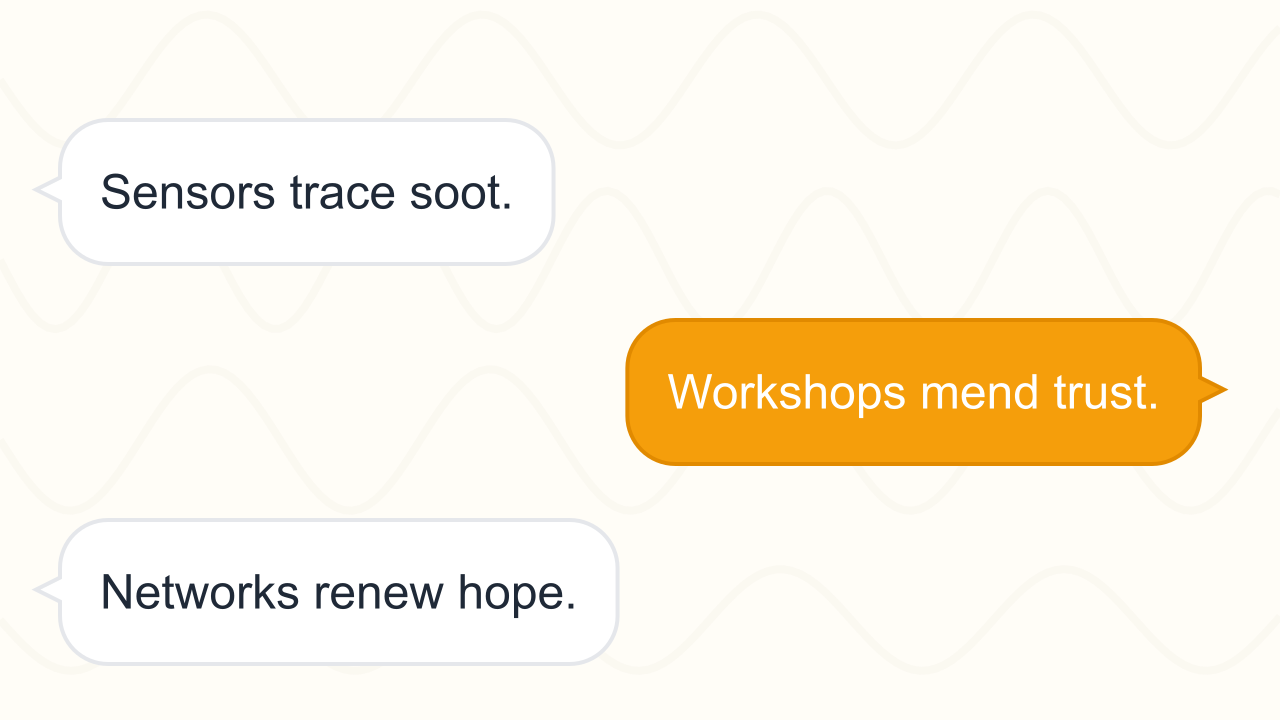
Designing Regenerative Networks for Future Neighborhoods
Trace how innovators, residents, and policymakers build interconnected solutions that cut pollution, expand recycling, and redesign everyday systems across six detailed case studies.
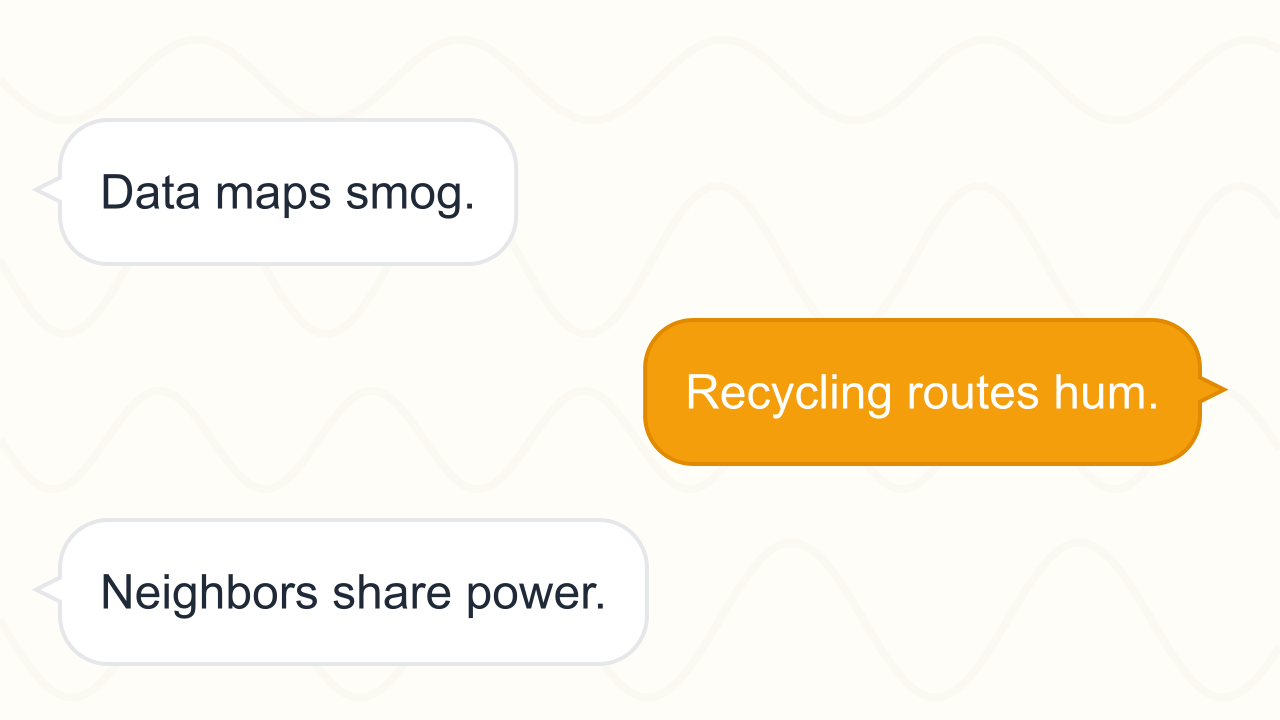
Clean Cycles for Tomorrow
Discover how neighborhoods reinvent waste systems, deploy new materials, and empower residents to shrink pollution footprints while expanding recycling access.
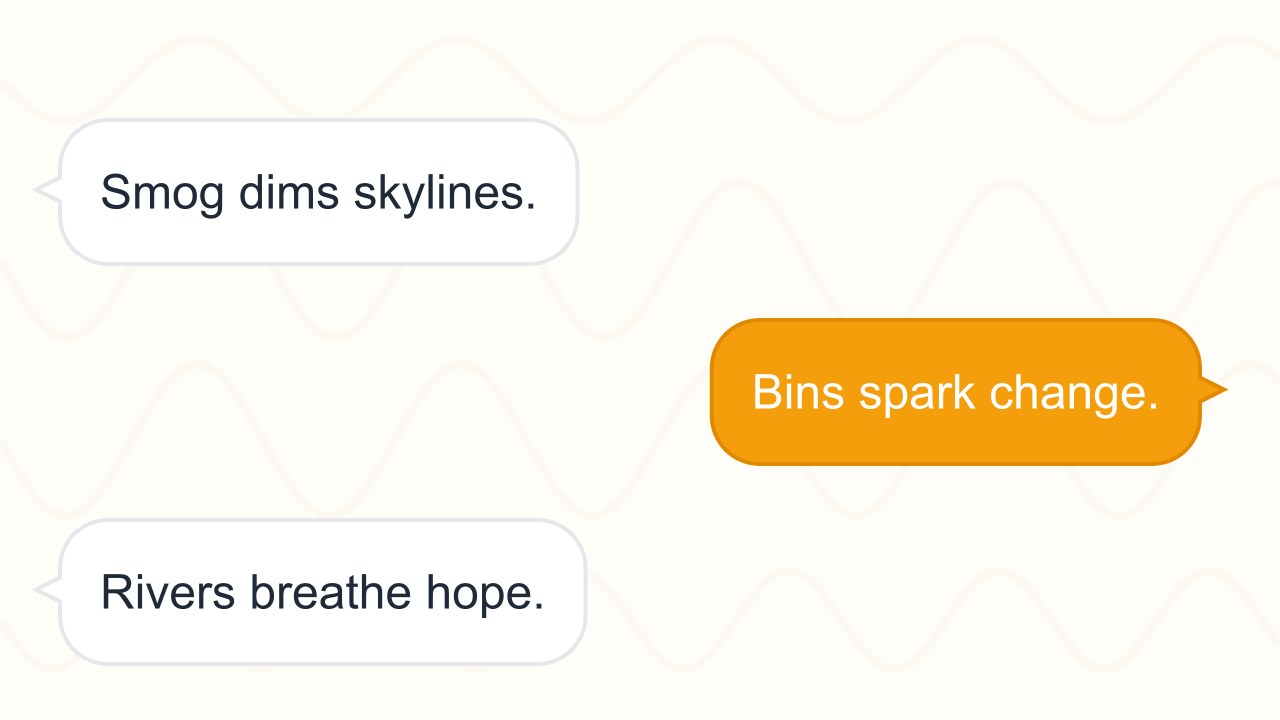
Pollution and Recycling: Restoring Our Cities
Explore how air, water, and waste pollution affect urban life, and examine the recycling innovations and community actions working to clean cities around the world.
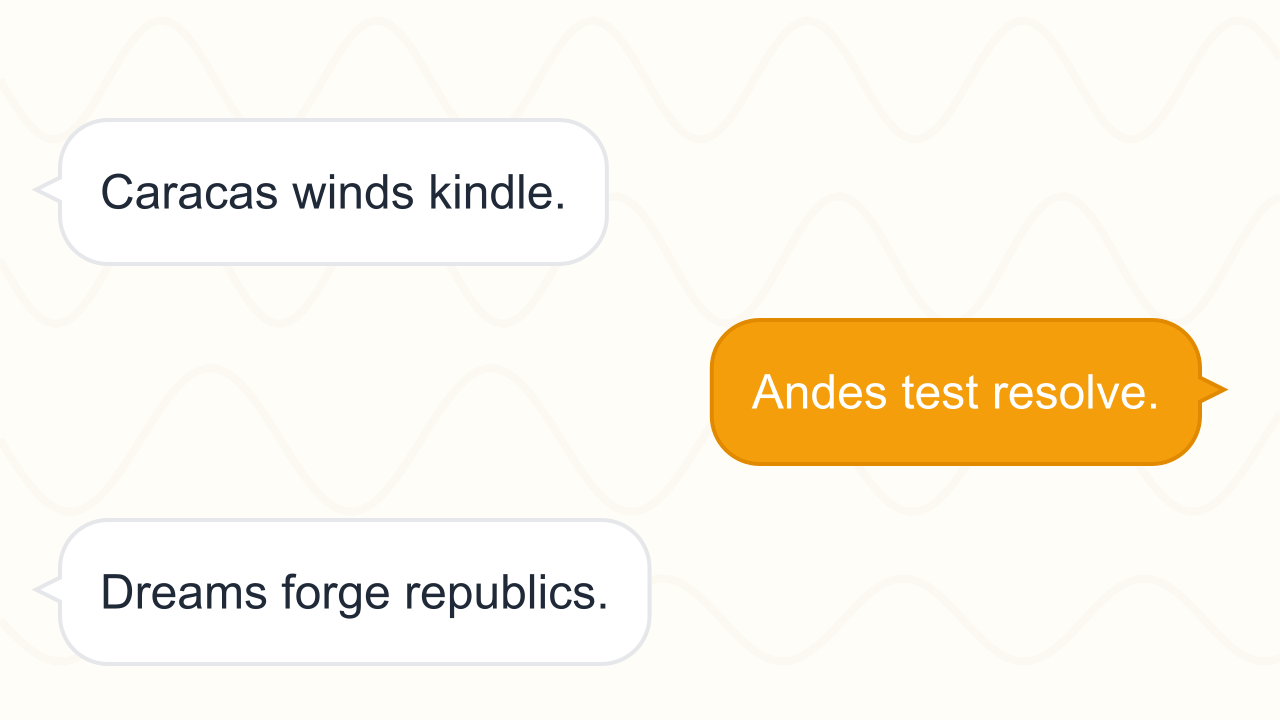
Simón Bolívar: Liberator of the Andes
Journey with Simón Bolívar from his Caracas youth through daring Andean campaigns and the struggle to define lasting republics across northern South America.
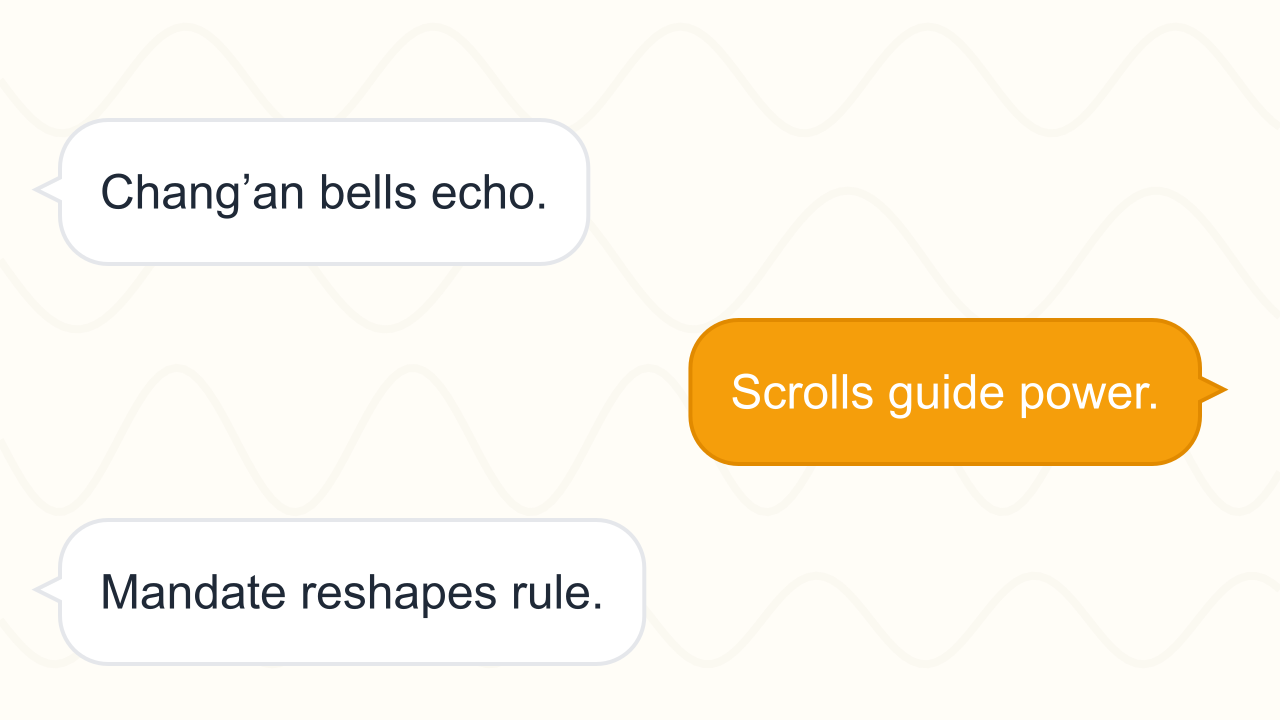
Wu Zetian: Mandate of the Tang
Follow Wu Zetian’s ascent from a palace attendant to emperor of the Zhou dynasty, examining how she wielded scholarship, alliances, and reform to shape eighth-century China.